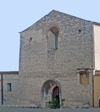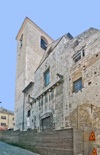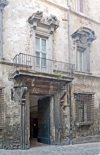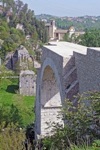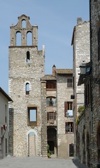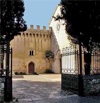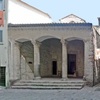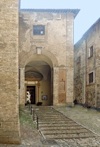San Giovenale (ca. 1047-1120)
The most important monument in Narni is the Duomo (San Giovenale)
, which was built outside the city walls, so that the shrine containing the relics of St Juvenal (later the Sacello di San Cassio) opened into the right wall of its nave. Pope Eugenius III consecrated it in 1145. The church was extended in the 14th century. Its interior was partially re-modelled in the Baroque period, following:
-
✴the translation of the relics of St Juvenal to the high altar in 1642; and
-
✴the beatification of the Blessed Lucy of Narni in 1710 and the translation in that year of some of her relics from Ferrara to San Giovenale.
Mendicant Churches
The city also contains the churches of the three most important mendicant orders, although only San Francesco can be visited (as at 2010):
Sant’ Agostino (late 14th century)
The Augustines acquired the church (12th century) of Sant’ Andrea della Valle here in 1266 at the instigation. Bequests were made for a new church from 1311, but its construction seems to have been delayed until the end of the century. The new church was built with its apse above the city wall, overhanging the steep cliff at the edge of the city. It was remodelled early in the 18th century and re-consecrated in 1728.
San Domenico (12th century)
Pope
Eugenius III consecrated this church, which was perhaps the first Duomo of Narni, as Santa Maria Maggiore in 1148. It was re-dedicated to San Domenico in 1303 when it passed to the Dominicans, who had settled outside the city in 1253. The interior
was remodelled in 1715, and the church was re-consecrated in 1728. It has been deconsecrtaed since the Naploeonic period. A room under the apse, which was was re-discovered in 1979, was used by the Inquisition. (See also the page on the adjacent subterranean church of Sant’ Angelo summarised below).
San Francesco (13th century)
According to tradition, Bishop Ugolino called St Francis to Narni in 1213, when he was staying at the Sacro Speco di Sant' Urbano
(see below). He established a second oratory on what was to become the site of San Francesco. Whatever the accuracy of the foundation stories, it is possible that the present church was begun soon after the death of St Francis in 1226. The Franciscans occupied the convent here until the suppression of 1860.
Other Important Monuments in Narni
Fountains of Narni
This page describes three of the fountains of Narni:
-
✴the civic fountain (1303) in Piazza dei Priori (illustrated here);
-
✴the civic fountain (ca, 1527) in Piazza Garibaldi, which was rebuilt after the sack of Narni; and
-
✴the Sorgente di Feronia, which stands on an ancient cult site.
Gates and Walls of Narni
-
✴two gates in the Roman walls:
-
•Arco Romano; and
-
•Porta del Vodano;
-
✴and five gates in the medieval circuit:
-
•Porta Pietra;
-
•Porta Romana;
-
•Porta Ternana (illustrate here);
-
•Porta Polella; and
-
•Porta della Fiera.
Palazzo Scotti (ca. 1568)
Cardinal Giovanni Bernardino Scotti commissioned this palace, which is attributed to Ippolito Scalzi.
Public Palaces
-
✴Palazzo Comunale (1273), illustrated here; and
-
✴Palazzo dei Priori (14th century).
Rocca di Narni(1367-78)
Cardinal Gil Albornoz built this fortress overlooking Narni when he restored papal control of Umbria.
Roman Bridges
This page describes two of the Roman bridges near Narn:
-
✴Ponte di Augusto (27 BC); and
-
✴Ponte Cardona (24 - 33 AD).
Sacro Speco di Sant’ Urbino (1213)
This was the site of a tiny oratory dedicated to St Silvester. St Francis is said to have stayed in a “speco” (grotto) here in 1213 and to have established a small Franciscan community on the site. St Bernardino of Siena revived the convent in the 15th century, and it subsequently became an important centre for the Observant reform.
Sant' Angelo (12th century)
This church was discovered in 1979 by cavers who were exploring the site of the demolished Convento di San Domenico. They also discovered the rooms of the convent that had been used by the Inquisition. Visits to this complex are arranged by Narni Sotterranea.
San Bernardo (date?)
The vestiges shown here are all that remains of
of the Cistercian nunnery of San Bernardo, which was demolished in the 19th century.
San Cassiano (10th century)
It is possible that the Byzantine general Belisarius built a fortified monastery here in ca. 537 to protect part of the Byzantine corridor through Lombard territory that linked Ravenna and Rome. The present complex probably enjoyed the patronage of the Roman noble Crescentius I (died 984). It passed to the Abbazia di Farfa in 1091. Sadly, it is now closed.
San Girolamo (restored 1465)
Cardinal Berardo Eroli built a church and convent on the site of an abandoned monastery for the Observant Franciscans in 1465. The complex was suppressed in 1860. It passed into private hands and was bough by the Commune in 1975, but it subsequently fell into disrepair.
Ospedale della Beata Lucia di Narni (1739)
Pope Clement XII consolidated the charitable institutions of Narni into a new hospice in 1739. It was initially established elsewhere in the city, but moved to this site in Piazza Galeotto Marzia in 1741. The complex passed to the Congregazione di Carità in 1864 and its activities were restricted to the care of orphans in 1883. It was renamed as the "Istituto Assistenza Infanzia Beata Lucia di Narni" in 1960 and continued its operations until 1980.
Santa Margherita (1602)
This nunnery, which was reserved, at least initially, for noble women, was suppressed in the 19th century, when the few remaining nuns moved to Santa Restituta (below).
Santa Maria Impensole (10th century)
This church was first documented in 1100, when a noble couple donated “Sancta Maria in Pisile” to the Abbazia di Farfa. The present church was probably completed in 1175, the date in an inscription over the portal.
Santa Maria del Piano (1483)
This church was also built on the site of an aedicule containing an image of the Madonna del Latte, which apparently performed a miracle in 1483. It seems to have belonged originally to a community of Clareni. The church was sacked by Imperial troops in 1527 and was transformed to the Observant Franciscans [of San Girolamo] in 1568. They left the convent in 1661 for unknown reasons. Their church subsequently became the cemetery church of Narni.
Santa Maria del Ponte (1716-22)
A chapel existed here from at least the 12th century, incorporated into a Roman structure that was probably associated with the nearby Ponte di Augusto. It was re-discovered in 1714, when a fresco of the Madonna and Child on its wall excited particular veneration. The present church was duly built, incorporating the rediscovered chapel behind its high altar. It was consecrated in 1728. Its facade, which was damaged by bombs in the Second World War, was rebuilt in 1946.
Santa Restituta (ca. 1563-1604)
This nunnery of Poor Clares enjoyed the patronage of the Cesi family. The few remaining nuns from Santa Margherita (above) moved here in the 19th century, when their nunnery was suppressed.
Return to the home page on Narni.



